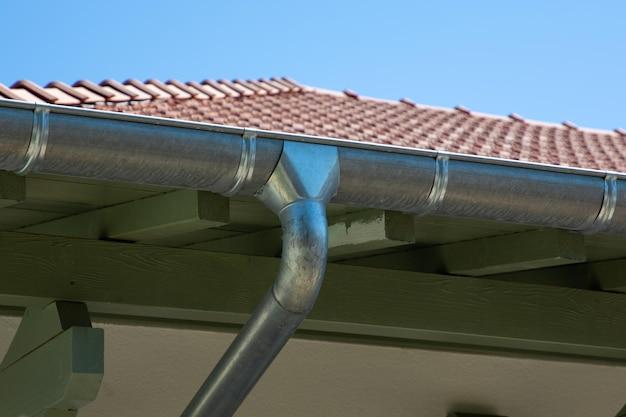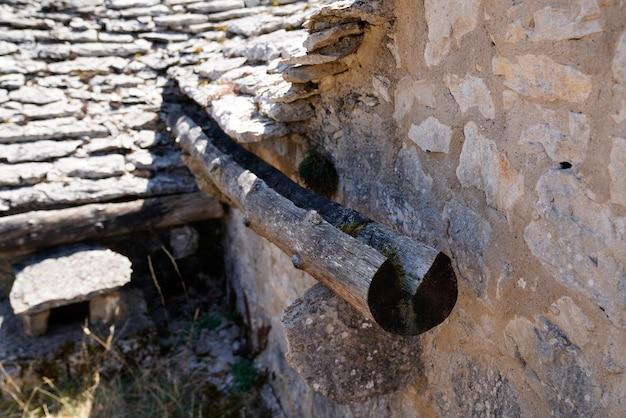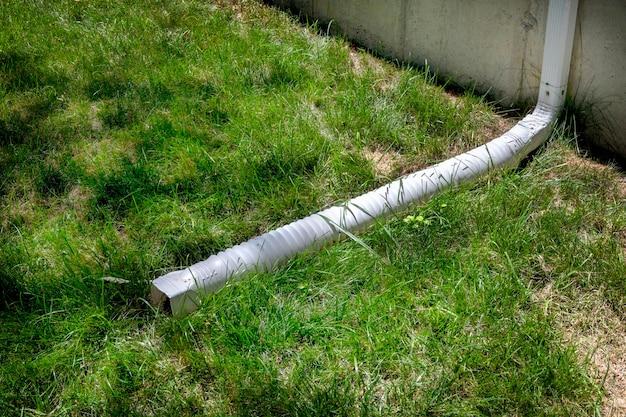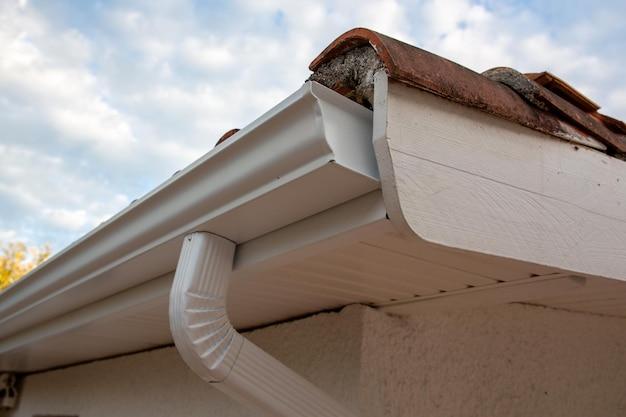Are you tired of constantly dealing with clogged gutter drains or leaky pipes? Don’t worry, we’ve got you covered! In this comprehensive guide, we will be discussing everything you need to know about repairing gutter drain pipes.
Gutter drainage pipes are an essential part of any home’s exterior, responsible for channeling rainwater away from the roof and foundation. However, over time, these pipes can become clogged or damaged, leading to water buildup and potential damage to your home’s foundation.
If you have experienced issues with your gutter drainage pipes and are unsure how to proceed, this guide will provide you with all the necessary steps and information needed to repair or replace your gutter drain system. From downspout drain pipe repair to underground gutter drainage pipe maintenance, we will cover it all.
So, if you’re wondering how to unclog gutter drain pipes or how to fix a broken gutter pipe, keep reading. We’ll provide you with tips, tricks, and expert advice on repairing drainage pipes, replacing gutter drains, and everything in-between.
Don’t let clogged or damaged gutter drain pipes cause damage to your home. With this comprehensive guide, you’ll be equipped with all the knowledge you need to keep your gutter drain system functioning correctly.
Gutter Drain Pipe Repair: Tips for Fixing Your Clogged Gutter Drain Pipes
If you are experiencing water overflow from your gutters during a heavy rainstorm, it might be a sign of a clogged gutter drain pipe. In this section, we will discuss some tips and tricks for fixing your clogged gutter drain pipes to avoid costly repairs and water damage.
Inspect Your Gutter Drain Pipes
Before tackling any repairs, you need to inspect your gutter drain pipes. Look for any signs of damage, such as cracks or holes, and make sure all the connections are tight. If you spot any damage, it will need to be repaired before proceeding.
Clear Out Debris
One of the most common causes of clogged gutter drain pipes is debris buildup, such as leaves, twigs, and dirt. You can remove the debris by using a garden hose to flush out the pipes or a plumber’s snake to break up any stubborn blockages.
Unclog With Vinegar and Baking Soda
For a more natural approach, you can use vinegar and baking soda to unclog your gutter drain pipes. First, pour half a cup of baking soda down the drain, followed by a cup of vinegar. Wait for about 30 minutes, then flush the pipes with hot water.
Use a High-Pressure Washer
If the above methods do not work, you can use a high-pressure washer to blast away any blockages. Keep in mind that a high-pressure washer can be dangerous, so ensure you wear protective gear.
Prevent Future Clogs
To prevent future clogs, you can install a gutter guard or a leaf-catching system. You can also regularly clean your gutters to keep them free of debris buildup.
In conclusion, clogged gutter drain pipes can cause significant damage if left unaddressed. By following the above tips, you can quickly and easily fix your clogged gutter drain pipes and prevent costly repairs.
Repairing Drainage Pipes
Have you noticed a problem with your gutter drain pipes? Perhaps they’re cracked, clogged, or leaking. No matter the issue, repairing your drainage pipes is imperative to prevent water damage to your home. Here are some steps you can take to repair your gutter drain pipes.
Assess the Damage
Before you start any repairs, you’ll need to assess the damage. Do you need to replace a section of pipe or fix a small leak? Do you need to clean out blockages? Take a close look at the pipe, and determine the extent of the damage.
Gather Your Tools
Once you’ve assessed the damage, gather your tools. You’ll likely need a hacksaw or pipe cutter, a screwdriver, PVC glue, replacement pipe (if necessary), and a ladder. Make sure you have everything you need before you start the repairs.
Cut and Replace Damaged Pipe
If you need to replace a section of pipe, use your hacksaw or pipe cutter to remove the damaged pipe. Measure the length of the pipe you removed, and cut a replacement piece to the same length. Apply PVC glue to the inside of the couplings, and attach the replacement piece.
Clear Blockages
If your drain pipe is blocked, you’ll need to clear the blockage. Begin by removing any debris from the top of the drain. You can use a garden hose with a high-pressure nozzle to flush out the blockage. If this doesn’t work, you may need to use a plumbing snake to clear the blockage.
Prevent Future Problems
To prevent future problems with your gutter drain pipes, make sure to clean them periodically. You can do this by flushing them out with a garden hose or using a plumbing snake to remove any blockages. Also, make sure to repair any damage as soon as you notice it to prevent further damage.
Repairing your gutter drain pipes is essential to prevent water damage to your home. By following these steps, you can easily repair your drainage pipes and prevent future problems.
Gutter Drain Replacement
If your gutter drain is so damaged that no repair will suffice, you might need a gutter drain replacement. Here’s what to expect during the replacement process:
Signs That You Need a Gutter Drain Replacement
- Your gutter drain is old and corroded
- The seams in the gutter drain are leaking water
- There are holes and cracks in the gutter drain
- The gutter drain is sagging or pulling away from the house
How to Replace a Gutter Drain
The first step is to remove the old gutter drain. You will need to unhook it from the downspout and loosen any screws holding it in place. It’s important to have someone hold the gutter in place while you remove it so that it doesn’t come crashing down.
Once the old gutter drain is removed, you will need to measure the length and angle of the replacement piece. Use these measurements to cut the new gutter drain to size.
Next, you will need to attach the new gutter drain to the downspout and secure it to the house with screws. Be sure to use caulk to seal any gaps between the gutter and the house.
Hiring a Professional
Replacing a gutter drain can be a challenging task, especially if you’re not handy with tools. It’s often best to hire a professional to handle the job for you. A professional gutter contractor will have the expertise and equipment needed to replace your gutter drain quickly and efficiently.
If your gutter drain is beyond repair, you may need to replace it. While this can be a more involved process than a simple repair, it’s important to address the issue to prevent water damage to your home. By knowing the signs of a damaged gutter drain and how to replace it, you can take the necessary steps to keep your home safe and dry.
Downspout Drain Pipe Repair
Once you’ve successfully repaired your gutter, you should also pay attention to your downspout drain pipe. These pipes carry water from your gutters and discharge it away from your house. Unfortunately, they can easily become clogged or damaged and cause water to overflow in the wrong places.
Signs of a Broken Downspout Drain Pipe
Some simple signs that indicate your downspout drain pipe needs repairing include cracks, rust, and pooling water around your house’s foundation. These can lead to costly foundation repairs and even water damage inside your home. However, repairing these issues is quick and affordable, especially if you detect them early.
How to Repair a Broken Downspout Drain Pipe
The first step in repairing a broken or clogged downspout drain pipe is to locate the problematic area. Trenching might be necessary, but sometimes the problem could be evident from the surface. Once you’ve done that, you can go ahead and use a plunger or an auger to unclog the pipe. If that doesn’t work, you may have to cut out the damaged section of the pipe and replace it with a new PVC pipe.
Prevention Tips
Prevention is often the best cure, so it’s imperative to take the time to maintain your downspout drain pipes. You can prevent future breakages by cleaning your gutters frequently, installing a gutter guard to keep out debris, and directing water away from the foundation of your home.
In conclusion, a damaged downspout drain pipe can be a significant problem for your home if not addressed quickly. Detecting and repairing these issues early can prevent costly repairs down the line. By following these simple repair and prevention tips, you’ll be sure to keep your downspout drain pipes in perfect working condition.
Underground Gutter Drainage Pipe
If you’re a homeowner, it’s essential to keep your gutter drainage system functioning correctly to prevent water damage to your house. One crucial element to consider is the underground gutter drainage pipe. These pipes are designed to carry water away from your home’s foundation and deposit it safely into a drainage system or a designated area that will not contribute to water pooling. Here are some essential things you need to know about the underground gutter drainage pipe.
Material Options
Underground gutter drainage pipes come in different types of materials. Each material has its own pros and cons, so it’s essential to make sure you choose the right one for your specific needs and budget.
-
PVC pipes: These pipes are the most commonly used underground gutter drainage pipe material because of their affordability and durability. They’re lightweight and easy to work with, making installation more accessible.
-
Corrugated pipes: These pipes are made of high-density polyethylene and are known for their flexibility. They can be easily bent to fit around corners and curves, making them a popular choice for homes with complicated gutter systems.
-
Metal pipes: These pipes are the most expensive option but are incredibly durable and long-lasting. They’re commonly used in high-end commercial or residential buildings that require a more aesthetically pleasing look.
Installation Process
Installing an underground gutter drainage system involves digging a trench along the length of your gutter downspouts and installing the pipes. It’s essential to double-check the slope of the trench to ensure water flows down the pipe away from the foundation. Once the pipes are installed, they need to be covered with backfill so that the ground is level.
Maintenance
After installation, it’s essential to perform regular maintenance on your underground gutter drainage system to ensure everything is functioning correctly. Regular checks and cleaning will help prevent clogging, which can lead to backups or damage to your foundation.
An underground gutter drainage system may seem like a small detail, but it plays a crucial role in protecting your home from water damage. Whether you choose PVC pipes, corrugated pipes, or metal pipes, proper installation and maintenance are essential to ensure your system’s longevity.
How to Unclog Gutter Drain Pipes
Gutter drain pipes can become clogged over time due to leaves, debris, and other materials. To unclog them, you can follow these simple steps:
Step 1: Check for Clogs
Start by checking the gutter drain pipes for clogs. You can do this by climbing up a ladder and inspecting the downspouts and gutters. Remove any debris that you can see, such as leaves and twigs.
Step 2: Use a Garden Hose
Next, use a garden hose to run water through the gutter drain pipes. Put the hose in the top of the downspout and turn on the water. Let the water run for several minutes, and see if it comes out at the bottom of the downspout. If it does not, there may be a clog that requires additional attention.
Step 3: Use a Plumbing Snake
If the garden hose does not work, you can use a plumbing snake to break up the clog. This tool can be purchased at a hardware store and is designed for unclogging pipes. Insert the snake into the top of the downspout and push it through the drain pipe until it meets the clog. Turn the snake handle clockwise to break up the clog, and then pull the snake out of the pipe.
Step 4: Repeat the Process
After using the plumbing snake, run the garden hose through the drain pipe again to ensure the clog is fully removed. Repeat the process until the water flows freely through the downspout.
By following these steps, you can unclog gutter drain pipes and ensure that your gutters function properly. It is recommended that you check your gutter drain pipes at least twice a year to prevent clogs from forming and causing damage to your home.
How to Fix a Broken Gutter Pipe
If you’re dealing with a broken gutter pipe, don’t panic; it’s a common issue that can be easily remedied. Here’s what you need to do:
Locate the Damage
First, you need to locate the damage. Look for leaks or cracks in the gutter pipe. Make sure to inspect the entire pipe, including corners and joints.
Determine the Extent of the Damage
Once you find the damage, it’s time to determine the extent of it. You don’t want to waste time and money fixing a small crack when the entire pipe needs to be replaced. If the damage is minor, you may be able to repair it with a simple patch. However, if the damage is severe, you’ll need to replace the entire gutter pipe.
Take Proper Safety Precautions
Before attempting any repairs, make sure to take proper safety precautions. Wear gloves and safety glasses to protect yourself from sharp edges and debris.
Fix the Crack
If the damage is minor, you can fix the crack with a patch. Clean the area around the crack with a wire brush, then apply a layer of roofing cement over the crack. Cover the area with a piece of galvanized metal flashing and a second layer of roofing cement. Let it dry thoroughly before testing for leaks.
Replace the Gutter Pipe
If the damage is severe, you’ll need to replace the entire gutter pipe. First, remove the damaged section of the gutter pipe. Then, measure the length of the section that needs to be replaced and purchase a replacement section. Cut the replacement section to the correct length and attach it to the existing gutter with screws and silicone caulk.
In conclusion, fixing a broken gutter pipe is not as complicated as it may seem. It’s important to locate and assess the extent of the damage, take proper safety precautions, and repair or replace the pipe accordingly. By following these steps, you can ensure that your gutter system functions properly and protects your home from water damage.



